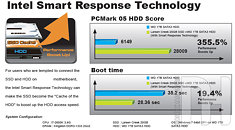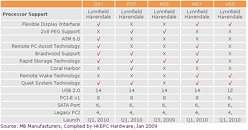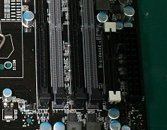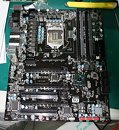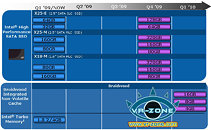Apr 6th, 2025 19:09 EDT
change timezone
Latest GPU Drivers
New Forum Posts
- What's your latest tech purchase? (23484)
- RX 9000 series GPU Owners Club (197)
- How I made an Ultimate Cooling Guide (26)
- 9070XT or 7900XT (33)
- i7-13700HX capped at 25 watts (12)
- I have a bricked XFX Radeon RX 580 8GB GPU. HELP! (15)
- What local LLM-s you use? (150)
- Share your AIDA 64 cache and memory benchmark here (3048)
- A dozen drivers for HD4670, and which do I choose? (7)
- Do you use Linux? (560)
Popular Reviews
- ASUS Prime X870-P Wi-Fi Review
- UPERFECT UStation Delta Max Review - Two Screens In One
- PowerColor Radeon RX 9070 Hellhound Review
- Corsair RM750x Shift 750 W Review
- DDR5 CUDIMM Explained & Benched - The New Memory Standard
- Upcoming Hardware Launches 2025 (Updated Apr 2025)
- Sapphire Radeon RX 9070 XT Pulse Review
- Sapphire Radeon RX 9070 XT Nitro+ Review - Beating NVIDIA
- AMD Ryzen 7 9800X3D Review - The Best Gaming Processor
- AMD Ryzen 9 9950X3D Review - Great for Gaming and Productivity
Controversial News Posts
- MSI Doesn't Plan Radeon RX 9000 Series GPUs, Skips AMD RDNA 4 Generation Entirely (146)
- NVIDIA GeForce RTX 5060 Ti 16 GB SKU Likely Launching at $499, According to Supply Chain Leak (126)
- Microsoft Introduces Copilot for Gaming (124)
- AMD Radeon RX 9070 XT Reportedly Outperforms RTX 5080 Through Undervolting (119)
- NVIDIA Reportedly Prepares GeForce RTX 5060 and RTX 5060 Ti Unveil Tomorrow (115)
- Over 200,000 Sold Radeon RX 9070 and RX 9070 XT GPUs? AMD Says No Number was Given (100)
- NVIDIA GeForce RTX 5050, RTX 5060, and RTX 5060 Ti Specifications Leak (97)
- Nintendo Switch 2 Launches June 5 at $449.99 with New Hardware and Games (92)
News Posts matching #Braidwood
Return to Keyword Browsing
Intel Smart Response Technology Detailed
Remember the very first strains of Ibex Peak LGA1156 platform motherboards such as this one? Remember that small memory slot next to the bigger DIMM slots? That was Intel's ambitious "Braidwood" technology, a NAND-flash based hard drive assist feature. Fast NAND flash memory would be installed onto the motherboard in the form of removable modules, and those modules would quicken system booting, and act as a fast cache for the system drive. Alas, Braidwood was axed for reasons unknown till date. Maybe it made Ibex Peak platform a lot faster than it should be, or maybe its design wasn't perfected or flawed. Regardles, it disappeared.
Two platforms (Ibex Peak and Cougar Point) later, a similar technology is making its way through Intel's pipes, this time it has a proper market name: Intel Smart Response Technology, and comes with another new development, Larsen Creek. Larsen Creek is the codename of Intel's upcoming line of solid state drives. However, it is targeting entry-level, low-capacity markets, and what better way to sell it than club it with Intel's new platform technology, Smart Response. Instead of NAND flash modules (Braidwood), Intel's Smart Response technology uses SATA SSDs to accelerate hard drives. The SSD can be of any size and speed, it's just that Larsen Creek is the most appropriate given that it will come in capacities as low as 20 GB, and be quite inexpensive.
Two platforms (Ibex Peak and Cougar Point) later, a similar technology is making its way through Intel's pipes, this time it has a proper market name: Intel Smart Response Technology, and comes with another new development, Larsen Creek. Larsen Creek is the codename of Intel's upcoming line of solid state drives. However, it is targeting entry-level, low-capacity markets, and what better way to sell it than club it with Intel's new platform technology, Smart Response. Instead of NAND flash modules (Braidwood), Intel's Smart Response technology uses SATA SSDs to accelerate hard drives. The SSD can be of any size and speed, it's just that Larsen Creek is the most appropriate given that it will come in capacities as low as 20 GB, and be quite inexpensive.

Braidwood Technology and P57 Chipset Get The Axe, Sources Claim
Intel's so codenamed "Braidwood" technology, which was touted to be a successor for Intel Turbo Memory, in which a supplementary high-speed, low-latency NVRAM module is used to speed up booting, application startup, and enhance system responsiveness in general, is shelved for now, and will not be part of Intel 5-series chipsets' feature-set, according to industry sources. As a result, Intel P57, a variant of P55 that officially supports it, will not be implemented, as Braidwood is the principal difference between it and P55. Several motherboard manufacturers already have the hardware-side of the technology ready, as several high-end LGA-1156 motherboards have been spotted with Braidwood NVRAM slots, or at least placeholders of the same. The software-side of it, however, seems to be the problem child, sources explained.

EVGA's Enthusiast Platform for LGA-1156 Processors Detailed
EVGA seems to have found its roots in Intel's 5-series chipset due to lack of chipsets from NVIDIA that support the latest Intel processors. In the process, EVGA gets to make Intel 5-series motherboards brandishing SLI support, as well as some pretty impressive enthusiast-grade features. With the X58 Classified series, EVGA took on the mighty ASUS to give out a full-featured motherboard for overclocking LGA-1366 processors. It looks like the company is working on another motherboard with similar credentials for LGA-1156 socket processors, based on the Intel P55/P57 chipset.
The EVGA 132-LF-E657 is a full-featured LGA-1156 motherboard focussed on overclocking. The CPU is powered by a lavish 12-phase circuit that makes use of DrMOS (driver-MOSFETs). The CPU socket further seats LICC (Low Inductance Ceramic Capacitors). Electrical stability is brought about by two 8-pin ATX CPU power connectors, a design first featured on the X58 Classified. Additional power stability for the expansion slots is brought about by a 4-pin Molex input. The four DDR3 DIMM slots are powered by a 3-phase circuit. Intel Braidwood technology is supported on this motherboard. The technology involves an NVRAM module that speeds up OS and applications loading. There are two clock generators on this board, perhaps to handle two independent clock domains that gives the user greater control over a few settings.
The EVGA 132-LF-E657 is a full-featured LGA-1156 motherboard focussed on overclocking. The CPU is powered by a lavish 12-phase circuit that makes use of DrMOS (driver-MOSFETs). The CPU socket further seats LICC (Low Inductance Ceramic Capacitors). Electrical stability is brought about by two 8-pin ATX CPU power connectors, a design first featured on the X58 Classified. Additional power stability for the expansion slots is brought about by a 4-pin Molex input. The four DDR3 DIMM slots are powered by a 3-phase circuit. Intel Braidwood technology is supported on this motherboard. The technology involves an NVRAM module that speeds up OS and applications loading. There are two clock generators on this board, perhaps to handle two independent clock domains that gives the user greater control over a few settings.
Foxconn P55 Inferno Katana and P55A Motherboards Pictured
Foxconn is ready with a socket LGA-1156 motherboard under its high-end Quantum Force series, a product line that includes popular models such as X58 Blood Rage for the Core i7, and X48 Black Ops for Core 2 series. This full-featured board is expected to pack a companion NVIDIA nForce 200 bridge chip alongside the Intel P55 chipset, which expands the board's PCI-Express capabilities by providing two PCI-Express x16 slots. The second x16 slot can divert 8 lanes to a third (black) PCI-Express x16 slot, giving this board 3-way SLI capability.
The CPU is powered by a 12-phase circuit. Four DDR3 DIMM slots support dual-channel DDR3 memory, while an additional NVRAM slot provides support for Intel Braidwood platform technology. Its six internal SATA II ports are wired to the P55 PCH, while additional controllers drive an IDE connector, and two eSATA ports. Gigabit Ethernet, Firewire, and 8-channel audio make for the rest of the mix. The board lacks display outputs, and hence doesn't support Intel Flexible Display Interface.
The CPU is powered by a 12-phase circuit. Four DDR3 DIMM slots support dual-channel DDR3 memory, while an additional NVRAM slot provides support for Intel Braidwood platform technology. Its six internal SATA II ports are wired to the P55 PCH, while additional controllers drive an IDE connector, and two eSATA ports. Gigabit Ethernet, Firewire, and 8-channel audio make for the rest of the mix. The board lacks display outputs, and hence doesn't support Intel Flexible Display Interface.

Intel SSD Roadmap Leaked
The guys over at VRZone have got their hands on the roadmap for Intel's SSD products. It has been said that Intel will be moving to a smaller fabrication process from 50 nm to 34 nm by Q4 2009 with capacities available up to 320 GB. The successor to Intel Turbo Memory has also been detailed, known as Braidwood and set for release in Q1 2010, it is said to, "provide SSD-like performance on second generation Ibex Peak chipsets like Q57, P57 and H57." Though to use Braidwood you will need, "Firmware support, Intel Rapid Storage Technology as well as the Braidwood module." These come in smaller capacities ranging from 4 GB to 16 GB, and will also be based on Intel's new 34 nm fabrication process. There is no official word on pricing as yet, but these new products are not expected to be cheap.
Apr 6th, 2025 19:09 EDT
change timezone
Latest GPU Drivers
New Forum Posts
- What's your latest tech purchase? (23484)
- RX 9000 series GPU Owners Club (197)
- How I made an Ultimate Cooling Guide (26)
- 9070XT or 7900XT (33)
- i7-13700HX capped at 25 watts (12)
- I have a bricked XFX Radeon RX 580 8GB GPU. HELP! (15)
- What local LLM-s you use? (150)
- Share your AIDA 64 cache and memory benchmark here (3048)
- A dozen drivers for HD4670, and which do I choose? (7)
- Do you use Linux? (560)
Popular Reviews
- ASUS Prime X870-P Wi-Fi Review
- UPERFECT UStation Delta Max Review - Two Screens In One
- PowerColor Radeon RX 9070 Hellhound Review
- Corsair RM750x Shift 750 W Review
- DDR5 CUDIMM Explained & Benched - The New Memory Standard
- Upcoming Hardware Launches 2025 (Updated Apr 2025)
- Sapphire Radeon RX 9070 XT Pulse Review
- Sapphire Radeon RX 9070 XT Nitro+ Review - Beating NVIDIA
- AMD Ryzen 7 9800X3D Review - The Best Gaming Processor
- AMD Ryzen 9 9950X3D Review - Great for Gaming and Productivity
Controversial News Posts
- MSI Doesn't Plan Radeon RX 9000 Series GPUs, Skips AMD RDNA 4 Generation Entirely (146)
- NVIDIA GeForce RTX 5060 Ti 16 GB SKU Likely Launching at $499, According to Supply Chain Leak (126)
- Microsoft Introduces Copilot for Gaming (124)
- AMD Radeon RX 9070 XT Reportedly Outperforms RTX 5080 Through Undervolting (119)
- NVIDIA Reportedly Prepares GeForce RTX 5060 and RTX 5060 Ti Unveil Tomorrow (115)
- Over 200,000 Sold Radeon RX 9070 and RX 9070 XT GPUs? AMD Says No Number was Given (100)
- NVIDIA GeForce RTX 5050, RTX 5060, and RTX 5060 Ti Specifications Leak (97)
- Nintendo Switch 2 Launches June 5 at $449.99 with New Hardware and Games (92)
